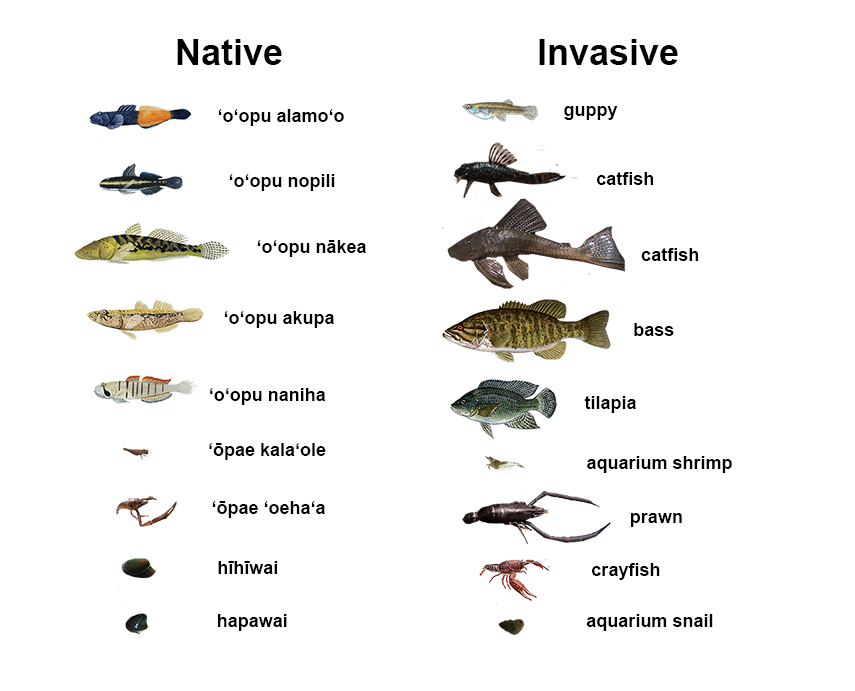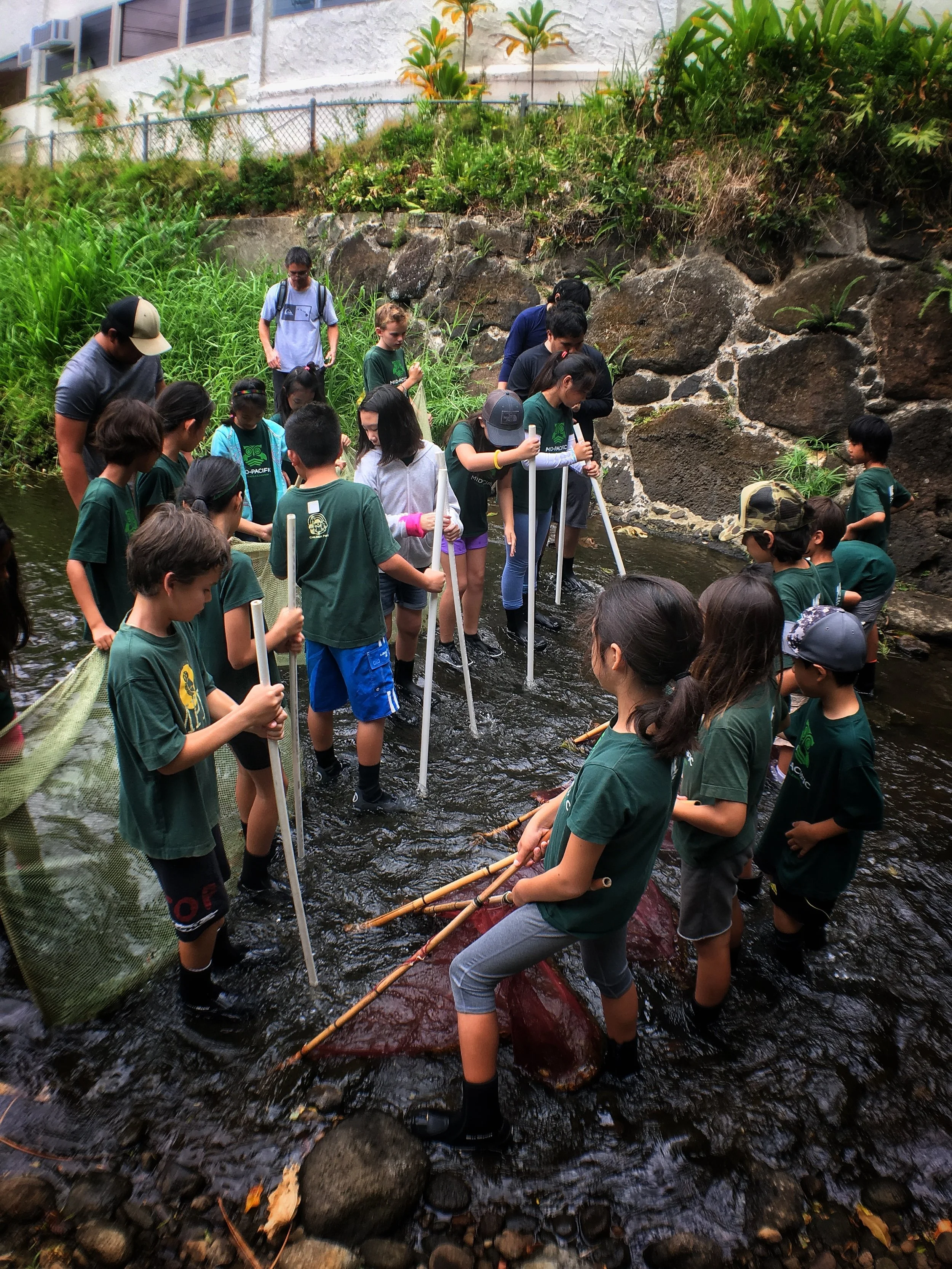Some background
In Hawai‘i, the freshwater macrobiota of relatively natural streams is dominated by native migratory species that have a marine larval phase but spend the juvenile and adult phases in freshwater. These migratory species include five endemic gobioid fishes, two crustaceans, and two mollusks (Figure 1). However, anthropogenic influences have drastically altered the environment of Hawaiian streams where native amphidromous freshwater stream species occur, e.g. introduction of non-native flora and fauna, riparian zone alteration, water diversions, stream channel modification and water quality degradation.
Figure 1. Varying level of landscape modifications in Hawaiian watersheds.
Although long-term habitat restoration efforts in highly urbanized landscapes are not realistic, we believe it is still possible to remove invasive species from waterways with considerable intensive effort. Most freshwater alien introductions come from the aquarium trade, where unwanted fish and macro-invertebrates are discarded in streams and other water bodies around the state (Figure 1). The largest populations and diversity of these aquarium-introduced species often correlates to human disturbance, and even locations where animals can be conveniently introduced to streams, i.e. road crossings in residential areas.
Figure 1. Native and invasive freshwater stream animals found in Hawai‘i.
What is the health of the stream as indicated by the freshwater biodiversity?
The Hawaiian Stream Index of Biological Integrity (HS-IBI) incorporates 11 metrics covering five ecological categories, and has shown to effectively differentiate relative environmental/habitat quality in streams on all Hawaiian Islands across gradients of human influence, from near-pristine to severely impaired.
To determine biological integrity scores for a given site, counts and measurements of fishes and macro-invertebrates are obtained by either underwater visual census or electrofishing techniques. The sites with the highest native species densities are designated as reference sites and obtain the maximum of 55 points (up to 5 points per metric). Any deviation in native species abundance and distribution, or presence of non-native species will result in lower HS-IBI scores.
Figure 2. Shift in biological integrity with human disturbance in Hawaiian Streams.
To educate the public about Hawai‘i’s native unique freshwater species and the effect of human influence on their populations, a collaborative effort was established between the University of Hawai‘i at Mānoa Center for Conservation Research and Training (UH-CCRT) and ‘Iolani School. Together, classroom curriculum and field protocols were developed for use in K-12 public and private schools in the Honolulu area, emphasizing environmental awareness through three sequential freshwater stream and watershed lessons (Figure 1).
Informative pdf on stream lessons by grade cohort for distribution: [K-2][3-5][6-8][9-12]
Video 1. Na wai ‘ekolu students participating in stream pa‘epa‘e survey in Lesson 3.
Since professional procedures are neither safe nor practical for K-12 students to perform, a modified “pa‘ēpa‘ē” survey was adapted for student groups. After being assigned to specific teams, where various seines, A-framed nets (‘ōpaenets), and PVC pipes are used to herd and trap animals in a predetermined length of a modeled stream (Figure 2). Participants familiarize themselves with the appropriate field equipment for their team, as well as the roles of other teams, in preparation for field application. The lesson requires≥30 minutes per class, but may require more time if entire grade levels participate. After rehearsing their field methods, participants are taken to a nearby stream site for field application, as Lesson 3. The pa‘ēpa‘ē stream bioassessment survey requires 45 per replicate, but performing the survey twice is strongly encouraged if time permits. Once captured, animals are identified to species, counted and measured. If the animal is non-native, it is removed from the site; if they are native they are temporarily held in aerated buckets of stream water and after being
Video 2. What happens to stream animals after capture?
All invasive animals were removed from the stream, and totaled over 41,000 animals (1600 pounds), and converted into compost or adopted as household pets from students, parents, and teachers. Native species were always released back to their capture location following the field activity (Video 2).
Preliminary annual biological integrity scores indicate a small increase in native species captured and biological integrity when averaged across all study sites, per field survey (Table 1). The number and biomass of invasive species captured decreased. Although early in this study, we hope that this positive trend continues to be observed in subsequent years. Despite having received high community support for this activity in a relatively short time, improvements in stream biological integrity and/or health of Hawaiian Streams will require more participation from more educational and professional institutions. By engaging in more environmental education workshops and symposia, we also hope to stimulate more community interest and maintain intensive efforts to improve stream health in Hawai‘i’s watersheds that need it most.
Click on a site above to view online google sheet for each site, or click here to view an interactive summary of graphed data.
To learn more see our 2020 Annual Report, DAR Special Activity Permit 2020-49, IACUC 20-3406.






